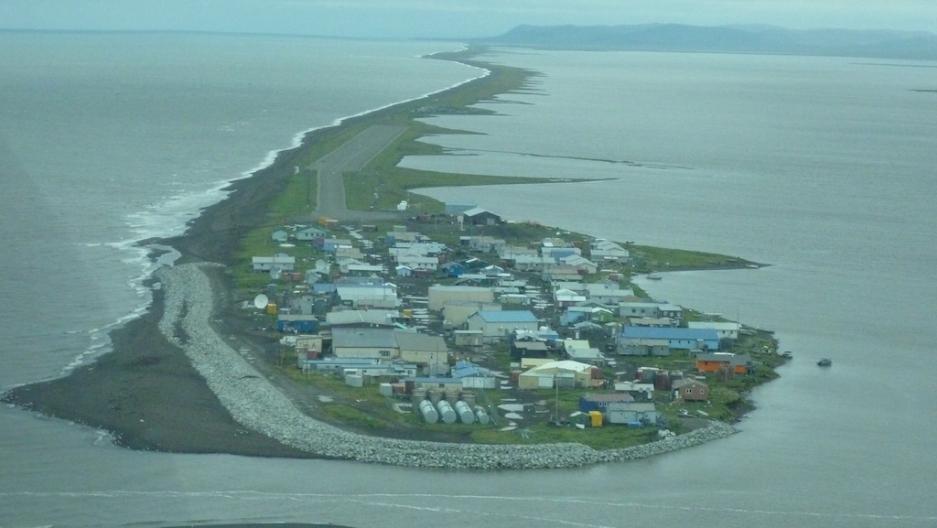Op-ed: Thawing Ground, Rising Stakes: Why Arctic Change Demands New Resilience

Permafrost in the village of Kivalina, Alaska, which is expected to succumb to coastal erosion. (Archive photo: Relocate Kivalina)
Op-ed: The melting of permafrost in the Arctic leads to a plethora of unwanted consequences, and there is an urgent need for action. "Waiting until permafrost thaws is a visible emergency will already be too late," writes Master of Environmental Management candidate at Yale University, Hassan Alzain, in this op-ed.
This is an opinion piece written by an external contributor. All views expressed are the author's own.
The Arctic is Melting—So is Our Margin for Error
Permafrost thaw is reshaping global risk landscapes. From Alaska to Siberia, it is destabilizing homes, causing floods, and forcing mass relocation. In Newtok, Alaska, chronic erosion is displacing families and destroying infrastructure—a glimpse into the future for other Arctic communities.
Unlike sudden disasters, this is a growing crisis driven by rising temperatures—hard to halt and harder to reverse. Scientists argue that gradual thaw gives communities time to adapt. However, this is not permission to delay action. The window for an effective response is narrowing fast.
Another alarming impact of thaw is the potential release of hidden carbon. Permafrost covers 24% of land in the Northern Hemisphere, storing nearly half of all organic carbon in the Earth’s soils.
Once considered a secure carbon sink, the Arctic is now a net carbon source. Thawing permafrost increases microbial activity, releasing carbon dioxide and methane into the atmosphere. Approximately 1,700 billion tons of carbon, nearly twice that present in the air and four times that from human industrial activity, are trapped in the permafrost.
If thaw continues unchecked, critical climate thresholds could be breached. The implications are severe, but there is still time for action. Due to “carbon cycle uncertainty,” new plant growth offers limited impact, with innovations and tools like methane capture and cooling systems representing the clearest path forward. This requires bold, coordinated, forward-thinking actions.
Transformational adaptation must surpass technical fixes.
Melting Ground, Rising Risks
What was once solid, frozen terrain is becoming increasingly unstable across the North American and Russian Arctic, leading to floods, land collapse, and erosion. Indigenous Alaskan and Scandinavian communities are disproportionately affected, facing loss of ancestral lands and cultural heritage despite contributing the least to the climate crisis.
The destruction of their homes and burial grounds are leading to displacement and trauma. However, they are often excluded from adaptation decisions, reflecting failures in procedural justice.
Beyond local impact, thaw disrupts cross-border infrastructure, threatening pipelines, trade routes, and airports. The gradual pace of thawing provides an opportunity to engineer adaptation strategies.
However, some scientists are concerned that the economic opportunities resulting from transboundary shifts are being used to justify expanding Arctic shipping routes and fossil fuel extraction. These transboundary shifts have the potential to produce ripple effects on global trade and climate diplomacy, making international coordination critical for guiding equitable, climate-resilient policy responses in adaptation planning.
Building a future that is physically stable and socially just will require developing technically sound, culturally grounded, and community-led solutions.
Thawing permafrost is also exposing buried biological and chemical threats. Pathogens once trapped in the ice, such as tularemia, vibriosis, and anthrax, are returning. In 2016, an anthrax outbreak in Siberia’s Yamal Peninsula infected over 70 people and killed a 12-year-old boy after thawed soil released dormant spores following a prolonged heatwave.
Such risks extend beyond disease—thaw may also compromise radioactive and toxic waste stored in Arctic soils. These hazards highlight system fragility and the need for equitable responses.
Engineering the Future: From Risk to Resilience
Although some argue that permafrost thaw will open Arctic shipping lanes and expose fossil fuel reserves, these benefits come with an additional cost. They intensify emissions, exacerbate the climate crisis, and deepen systemic vulnerabilities.
Transformational adaptation must surpass technical fixes. Engineering solutions, though essential, must be only a part of strategies addressing physical and social vulnerability. For example, deep foundation piles that reach stable soil layers and thermosyphons that stabilize ground temperatures and reduce permafrost thaw provide technical interventions that align with the resist and accept components of the “Resist–Accept–Direct” (RAD) framework.
However, these approaches only reduce infrastructure risks and are therefore only part of the solution.
Non-technical responses are equally essential, particularly among Indigenous communities facing loss of cultural sites and burial grounds. Adaptation must include relocation, heritage preservation, and inclusive governance reflecting community priorities. These responses require participatory planning focused on justice and resilience.
Building a future that is physically stable and socially just will require developing technically sound, culturally grounded, and community-led solutions.
A Time for Visionary Action, Not Denial
Despite several scientists sounding the alarm on permafrost thaw, the real choice is not between fear and optimism, but between complacency and transformative action.
Transformational adaptation requires more than quick fixes or reactions. It involves establishing relocation systems before forced displacement occurs, phasing out fossil fuel exploration even if it is economically attractive in the short term, and increasing financing for climate adaptation strategies that prioritize justice.
Furthermore, we must embed Indigenous knowledge into national planning processes, design thaw-resistant infrastructure, and introduce legal safeguards for climate-displaced populations. If we take the path of inaction, this crisis will not remain confined to the Arctic, so we need widespread action. The path forward requires foresight, investment, and inclusive governance.
Waiting until permafrost thaws is a visible emergency will already be too late.

